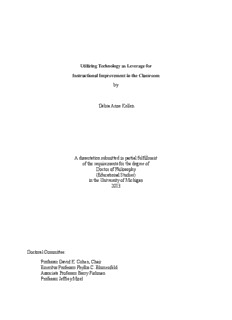Table Of ContentUtilizing Technology as Leverage for
Instructional Improvement in the Classroom
by
Debra Anne Kellen
A dissertation submitted in partial fulfillment
of the requirements for the degree of
Doctor of Philosophy
(Educational Studies)
in the University of Michigan
2013
Doctoral Committee:
Professor David K. Cohen, Chair
Emeritus Professor Phyllis C. Blumenfeld
Associate Professor Barry Fishman
Professor Jeffrey Mirel
© Debra A. Kellen 2013
DEDICATION
In loving memory of my grandparents
Ben and Betty Kofsky.
Though many years have passed,
you are dearly remembered.
Your strong moral compass
continues to guide me today.
ii
ACKNOWLEDGEMENTS
First, and foremost, I would like to extend my thanks to this district‘s middle school
facilitator for making this dissertation possible. I am forever grateful to her for how she
welcomed me into the district and set the tone for my inclusion and acceptance within the group.
Her skill as a teacher, her laughter and enthusiasm, and her tireless support for the many teachers
attempting to improve their practice were an inspiration.
I would also like to take this opportunity to thank all the teachers, facilitators,
administrators and superintendents for volunteering to participate in the study and graciously
allowing me to watch as you worked together to improve your teaching and your schools. I feel
deeply honored to have been a part of Inspire.
Next, I would like to express my appreciation to the members of my dissertation
committee: David Cohen, my dissertation chair, for your guidance through the dissertation
process. Jeff Mirel, my first professor in Graduate School, for suggesting that I consider
pursuing a doctoral degree. Phyllis Blumenfeld for your patience, on-going encouragement and
careful questioning of my research. I thoroughly enjoyed our many conversations as you helped
me develop the ideas represented here. Last, but not least, Barry Fishman for your many probes
and suggestions.
iii
I would also like to thank the faculty at the School of Education here at the University of
Michigan who provided me with the knowledge and experiences integral to this work and which
I will continue to use throughout my career.
A very special thank you is owed to my parents, Ethel and Ron Kellen, for instilling in
me a sense of intellectual curiosity, for encouraging me to accomplish all that I set out to do, and
for modeling how to balance the pursuit of these goals with the raising of a family. Throughout
my life, you have been tireless cheerleaders for all my endeavors. I am blessed to have you both.
Last, but not least, I am genuinely grateful to my husband, Ron, our daughters, Beth and
Jacalyn, and my sisters, Nance and Jonna, for all their support and encouragement throughout
this long journey.
Thank you all!
iv
TABLE OF CONTENTS
DEDICATION ................................................................................................................................ ii
ACKNOWLEDGEMENTS ........................................................................................................... iii
LIST OF DIAGRAMS ................................................................................................................. viii
LIST OF APPENDIXES............................................................................................................... .ix
INTRODUCTION .......................................................................................................................... 1
CHAPTER 1 Review of the Literature ........................................................................................... 8
1.1 A Quick Look Back ...................................................................................................... 8
1.2 21st Century Teaching and Learning .......................................................................... 11
1.3 Technology in Schools and Classrooms ..................................................................... 18
1.4 Effective Professional Development for Teachers ..................................................... 24
1.5 TPACK: Technological Pedagogical Content Knowledge ....................................... 30
1.6 Educational Leadership .............................................................................................. 34
CHAPTER 2 Inspire ..................................................................................................................... 42
2.1 The District ................................................................................................................. 42
2.2 The Development of Inspire ....................................................................................... 44
2.3 Goals ........................................................................................................................... 49
v
2.4 Professional Development .......................................................................................... 55
CHAPTER 3 Research Methodology ........................................................................................... 63
3.1 Participants ................................................................................................................. 63
3.2 Research Questions..................................................................................................... 66
3.3 Data Collection Procedures ........................................................................................ 67
3.4 Data Analysis .............................................................................................................. 73
3.5 Trustworthiness of the Findings ................................................................................. 74
3.6 Limitations .................................................................................................................. 76
CHAPTER 4 Findings .................................................................................................................. 78
4.1 Professional Development: Defining Goals, Values, and Expectations for Practice 78
4.2 Professional Development: Building Technological and Pedagogical Capacities .... 84
4.3 School Leadership and School Culture ...................................................................... 96
4.4 Other Conditions that Supported or Inhibited Instructional Change ........................ 103
CHAPTER 5 Discussion and Conclusions ................................................................................. 111
5.1 Summary of Results.................................................................................................. 111
5.2 Discussion ................................................................................................................. 114
5.3 Limitations ................................................................................................................ 129
5.4 Suggestions for Future Research .............................................................................. 130
APPENDIX A Teacher Interview Guide ................................................................................... 133
vi
APPENDIX B Facilitator Interview Guide............................................................................... 138
APPENDIX C Administrator Interview Guide.......................................................................... 141
APPENDIX D Survey Instrument 1 .......................................................................................... 145
APPENDIX E Survey Instrument 2 ........................................................................................... 147
APPENDIX F Outline of the Monthly Training Sessions ......................................................... 150
APPENDIX G Coding Scheme for Transcripts and Interviews ................................................ 159
APPENDIX H Coding Scheme for Surveys .............................................................................. 175
REFERENCES ........................................................................................................................... 177
vii
LIST OF DIAGRAMS
A. A New Balance: Education for the 21st Century .………..………………….….. 13
B. P21 Common Core Toolkit: A Framework for 21st Century Learning ….…..…. 16
C. TPACK: Technological Pedagogical Content Knowledge …………………..… 32
D. Specifying Goals and Expectations for Inspire ………………………………… 83
viii
LIST OF APPENDIXES
A. Teacher Interview Guide ………………………………………………………….. 134
B. Facilitator Interview Guide …………………..……………………………………. 139
C. Administrator Interview Guide ……………………………….…………………… 142
D. Survey Instrument 1 …………………………………………….…………………. 146
E. Survey Instrument 2 ……………………………………………………………….. 148
F. Outline of the Content of the Monthly Training Sessions ……….………………... 151
G. Coding Scheme for Transcripts and Interviews …………………….……………... 159
H. Coding Scheme for Surveys ……..………………………………….….……..…… 175
ix
Description:APPENDIX F Outline of the Monthly Training Sessions . the teacher's role in the classroom away from that of the imparter of . The idea is to allow students to build mental models (either visceral or virtual), (such as McGraw-Hill, Houghton-Mifflin Harcourt, LEGO, Crayola or Scholastic), and.

